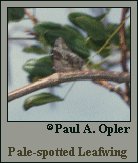 |
 

 |



Pale-spotted Leafwing (Anaea pithyusa [R. Felder])
Wing span: 2 1/4 - 3 inches (5.7 - 7.6 cm).
Identification: Upperside is black and dark blue; forewing with pale blue spots; hindwing with a tail. Underside mimics a dead leaf.
Life history: Males perch on trees to wait for females. Eggs are laid singly under leaves of host plant; caterpillars eat leaves. Young caterpillars make a perch out of a leaf midvein; older ones live in a rolled leaf shelter.
Flight: The wet season form flies from November-March; the dry season form from May-September. Flies in South Texas in March, July, September, and November.
Caterpillar hosts: Cuala (Croton lucidus) in the spurge family (Euphorbiaceae).
Adult food: Rotting fruit and dung.
Habitat: Open subtropical forests.
Range: Peru and Bolivia north through Central America to Mexico and the lower Rio Grande Valley of South Texas.
Conservation: Not required for rare tropical stray.
The Nature Conservancy Global Rank: G5 - Demonstrably secure globally, though it may be quite rare in parts of its range, especially at the periphery.
Management needs: None reported.
References:
Opler, P. A. and V. Malikul. 1992. A field guide to eastern butterflies. Peterson
field guide #4. Houghton-Mifflin Co., Boston. 396 pages, 48 color plates.
Scott, J. A. 1986. The butterflies of North America. Stanford University Press,
Stanford, Calif. 583 pages, 64 color plates.
Author: Jane M. Struttmann

